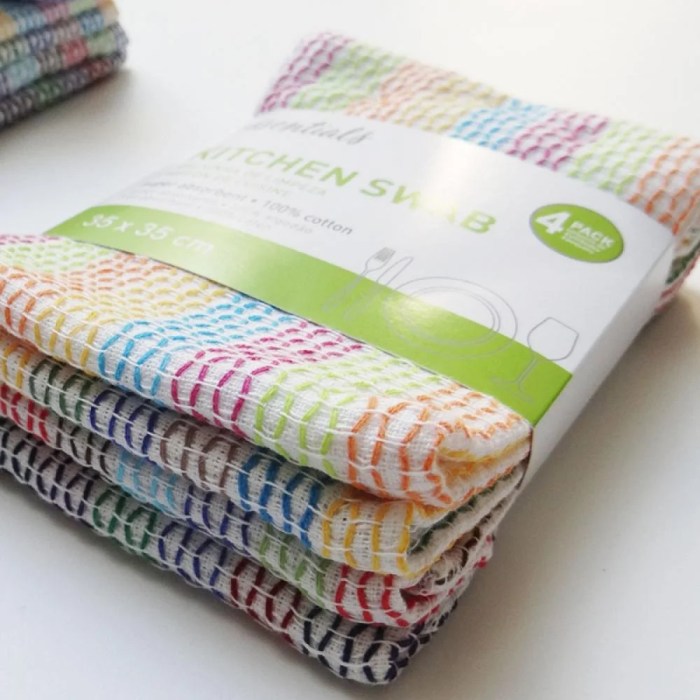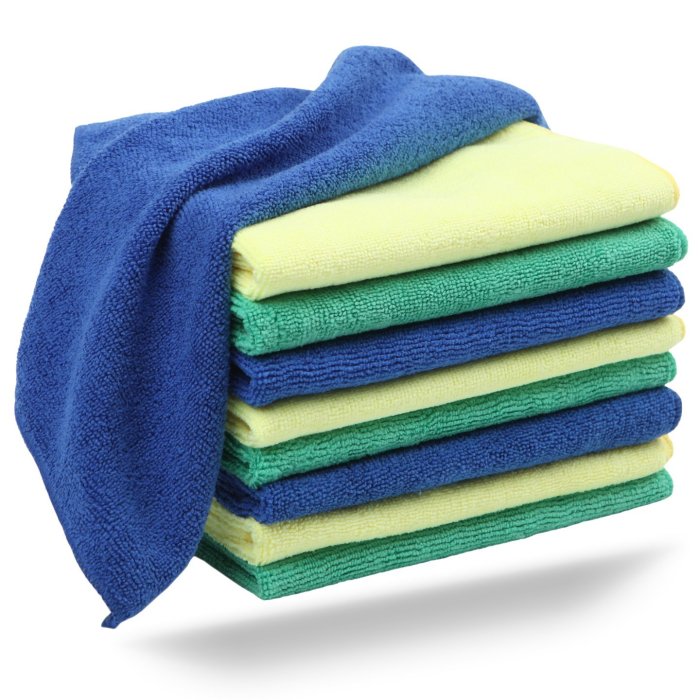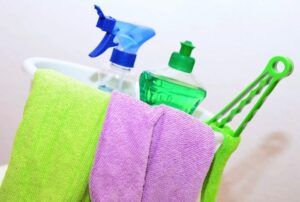
Reusable cleaning cloths have emerged as a sustainable alternative in our quest for a cleaner and greener environment, allowing us to tackle messes without the guilt of contributing to waste.
Not only do they significantly reduce the amount of disposable waste generated, but they also offer notable cost savings and enhance cleaning efficiency, making them a practical choice for both households and businesses.
Benefits of Reusable Cleaning Cloths

Switching to reusable cleaning cloths offers a multitude of advantages that extend beyond mere practicality. These benefits range from significant environmental impacts to financial savings and improved cleaning performance. By integrating reusable cloths into your cleaning routine, not only are you making a smart personal choice, but you’re also contributing positively to the planet.
Environmental Advantages
The use of reusable cleaning cloths dramatically lessens the environmental burden associated with traditional disposable options. Each year, millions of tons of disposable cleaning products contribute to landfills, where they can take decades to decompose. Reusable cloths, on the other hand, can be washed and reused hundreds of times, greatly reducing waste.
Switching to reusable cleaning cloths can prevent thousands of disposable cloths from ending up in landfills.
By opting for reusable cloths, you help conserve resources needed for production and packaging, leading to lower carbon emissions associated with manufacturing and transportation of disposable options. This shift promotes a more sustainable approach to cleaning and aligns with the growing focus on eco-friendly living.
Cost Savings
Transitioning to reusable cleaning cloths can lead to significant financial benefits. Initially, the investment in a set of quality cloths may seem higher compared to a pack of disposables; however, the long-term savings become clear over time. Consider the following aspects of cost savings:
- Reusable cloths can be cleaned and used repeatedly, eliminating the need for continuous purchases of disposable options.
- Over time, the cost of buying disposable cloths adds up; switching to reusables can save households upwards of hundreds of dollars annually.
- Many reusable options can withstand numerous washes, making them a cost-efficient investment compared to single-use products.
These factors demonstrate how reusable cleaning cloths can positively impact your budget while also promoting responsible consumption.
Improved Cleaning Efficiency
Reusable cleaning cloths are designed to enhance cleaning effectiveness, often outperforming their disposable counterparts. Their construction typically allows for better absorption and durability, making them more effective at picking up dirt, grime, and bacteria.Key points regarding their efficiency include:
- The fabric used in reusable cloths often provides superior scrubbing power, enabling more thorough cleaning.
- Many reusable cloths are designed for specific tasks, such as streak-free shine for glass surfaces or extra absorbency for spills, improving overall cleaning results.
- Using reusable cloths reduces the need for multiple products, as many can be used across different surfaces and applications without leaving residues.
By opting for reusable cleaning cloths, you not only clean more effectively but also simplify your cleaning process, leading to a more efficient use of time and resources.
Types of Reusable Cleaning Cloths

Reusable cleaning cloths come in various materials, each designed to tackle different cleaning tasks effectively. Understanding these materials can help you choose the right cloth for your specific needs, enhancing your cleaning routine while promoting sustainability. The three most common types of reusable cleaning cloths are microfiber, cotton, and bamboo. Microfiber cloths are made from synthetic fibers that are finer than human hair, making them incredibly effective at trapping dust, dirt, and grime.
Cotton cloths, on the other hand, are natural fibers known for their absorbency and softness, making them ideal for a range of cleaning tasks. Bamboo cloths are derived from the bamboo plant, offering an eco-friendly alternative with antimicrobial properties. Each material serves distinct purposes in cleaning, so it’s essential to know where each one excels to maximize efficiency.
Comparison of Cleaning Cloth Materials
The choice of cleaning cloth material impacts both effectiveness and usability. Here’s a breakdown of the pros and cons of microfiber, cotton, and bamboo cleaning cloths, along with their specific uses:
| Material | Pros | Cons | Best Uses |
|---|---|---|---|
| Microfiber |
|
|
|
| Cotton |
|
|
|
| Bamboo |
|
|
|
Choosing the right type of reusable cleaning cloth not only enhances cleaning effectiveness but also supports sustainable practices.
Best Practices for Maintaining Reusable Cleaning Cloths
Maintaining reusable cleaning cloths is essential for ensuring their effectiveness and longevity. By following a few best practices, you can keep your cloths clean, hygienic, and in prime condition for all your cleaning needs. Proper care not only extends the life of the cloths but also contributes to a healthier home environment.One critical aspect of maintaining reusable cleaning cloths is proper washing and sanitizing.
This process not only removes dirt and grime but also eliminates harmful bacteria that can linger on the fabric. The following methods are highly effective for washing and sanitizing your cloths, ensuring that they remain clean for future use.
Washing and Sanitizing Techniques
To effectively wash and sanitize your reusable cleaning cloths, consider the following methods:
1. Machine Washing
Use hot water (at least 140°F) with a suitable detergent to wash cloths. This temperature helps to kill bacteria and remove stains.
2. Hand Washing
If machine washing is not an option, use a bucket with hot soapy water. Soak the cloths for a few minutes, then scrub them gently and rinse thoroughly.
3. Sanitizing
After washing, you can sanitize cloths by adding white vinegar or bleach to the rinse cycle. For bleach, use a diluted solution (1 tablespoon per gallon of water) and ensure it is safe for the fabric type.
4. Drying
Always dry cloths thoroughly to prevent mildew. You can air-dry them in direct sunlight, which naturally disinfects, or tumble dry on a high heat setting.
Color-Coding for Different Cleaning Tasks
Implementing a color-coding system for your reusable cleaning cloths is a smart way to avoid cross-contamination. By assigning specific colors to particular cleaning tasks, you can minimize the risk of spreading germs from one area to another. For instance, you might designate:
Red Cloths
For kitchen cleaning, including wiping countertops and surfaces.
Blue Cloths
For bathroom cleaning, ideal for sinks and toilets.
Green Cloths
For dusting and general household cleaning.
Yellow Cloths
For glass and window cleaning. This system makes it easy to remember which cloth to use where, enhancing your cleaning routine’s efficiency and hygiene.
Effective Storage Solutions
Proper storage of reusable cleaning cloths is vital for maintaining their cleanliness and preventing any contamination. Here’s a step-by-step guide to ensure your cloths are stored hygienically:
1. Clean Storage Containers
Use airtight containers or designated storage bins to keep your cloths organized. This prevents dust and dirt from settling on them.
2. Separate by Purpose
Store cloths used for different tasks in separate containers to reduce the risk of cross-contamination.
3. Labeling
Label each container with its designated cleaning task (e.g., Kitchen, Bathroom) for easy identification and quick access.
4. Dry Before Storing
Always ensure cloths are completely dry before placing them in storage. This helps prevent mildew and unpleasant odors.
5. Regular Rotation
Rotate your cloths regularly, ensuring even wear and preventing any one cloth from becoming overly worn or stained.Following these best practices will not only extend the life of your reusable cleaning cloths but also enhance the cleanliness and safety of your home. By washing, color-coding, and storing your cloths properly, you create a more efficient cleaning process that keeps your environment fresh and hygienic.
End of Discussion
In conclusion, embracing reusable cleaning cloths not only supports our planet by minimizing waste but also empowers us to maintain a cleaner living space more effectively and economically.
Query Resolution
How do I wash reusable cleaning cloths?
Wash them in hot water with detergent, and avoid using fabric softeners to maintain absorbency.
Can I use bleach on reusable cleaning cloths?
Yes, but use it sparingly as it can damage the fabric over time; opt for color-safe bleach if possible.
How often should I replace reusable cleaning cloths?
Typically, you can replace them every 6-12 months depending on usage and wear.
Are reusable cleaning cloths safe for all surfaces?
Most are safe for various surfaces, but always check the manufacturer’s guidelines for specific recommendations.
Can I use fabric softener when washing them?
No, fabric softener can decrease the absorbency of the cloths, so it’s best to avoid it.




